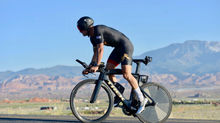Raceday Mechanicals
- Jason Lentzke
- Jun 3, 2023
- 3 min read
Dealing with bike issues and mechanicals is a part of racing. If you race long enough, it’s inevitable. You’ve spent thousands of hours and months training for this event. Don’t rely on race support, be prepared and self-sufficient. Follow these tips to make your mechanicals a little more tolerable.

Keep it Clean
There is nothing more disturbing than looking at a filthy, poorly maintained $9,000 bike. Keep your bike performing efficiently with a little preventative maintenance. Wash your bike once per week, clean and lube your chain, cassette and jockey wheels. Invest in a few simple cleaning products and embrace your inner bike snob. The front end of triathlon bikes are especially susceptible to sweat and grime so pay special attention to the headset and front brake cables. Take your bike to the shop every few months to make sure things are functioning properly. A clean bike is a fast bike! Lastly, don’t forget to schedule your race day tune up roughly two weeks before your key event.

Photo Credit: Bike Radar
Flat Kit
A proper race day flat kit includes a tire lever, C02 cartridge, inflator and a tube with an appropriate length valve stem. Wrap it all in a rubber band so it’s small enough to fit in your jersey or somewhere out of the wind attached to your bike. If you race with a spare tubular, make sure it’s pre-stretched and then tuck it under your saddle. Be sure to include a razorblade to cut the tire if you’re unable to rip the tire off the rim with your hands.
Clinchers or Tubular
For some, changing a clincher is easier and more convenient than changing a tubular tire. Others find changing a tubular more convenient. A tubular tire is glued to the rim so there is no tube to remove when you’re changing a flat. They also tend to be less vulnerable to flatting, especially pinch flats. Because there’s no tube, this allows for “riding-in” on a flat if you’re relatively close to T2. However, when you need to change the tubular you will need to rip the tire off the rim, install a new tubular or gamble with a can of sealant. Mastering the art of changing a tubular takes practice. If you don’t train on tubulars, you’re really not going to get an opportunity to practice. Personally, I prefer to ride on clinchers because I practice changing the tubes fairly frequently and if you’re racing on good rubber, the chances of flatting are minimal. If you need more evidence to race on clinchers, bear witness to one of the most epic meltdowns in Kona after two-time Ironman World Champion, Normann Stadler, punctures a tubular for the second time.
Race on Good, High Quality Rubber
The combination of high thread count tires and latex tubes can save you 1-3 watts per tire. The Continental 4000s II is a great combination of speed and protection within a high thread count tire. For long course triathlon, it’s definitely the gold standard. Make sure the tires you race on haven’t seen any high volume training weeks. Before you rack your bike in transition, inspect the tires for cuts and excessive wear. Ideally, set aside a pair of tires that you save for racing. Always pump those tires to the appropriate PSI on race morning, not the night before. Speaking of the night before, that’s the ideal time to clean and lube your chain.
Ironman is all about problem management and staying positive. Control what you can control and manage all emotional cycles (hold back on the peaks, endure the valleys). If and when you have to deal with a bike mechanical issue, keep your cool and figure out what you need to do. I’ll leave you with this: 7x Ironman Champion Chris McDonald punctured twice at 2013 Ironman Coeur d’Alene and then went on to finish fifth after closing with a 2:48 marathon. Keep your head in the game!





























Comments